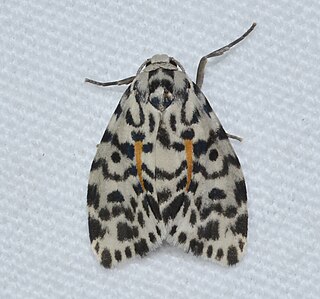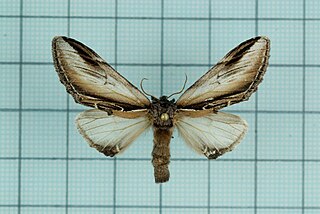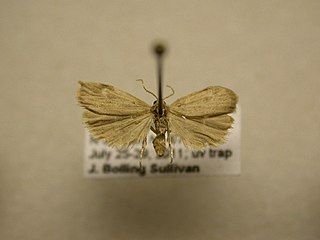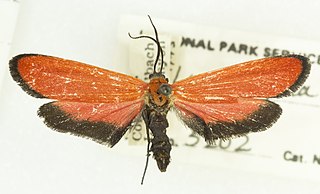
The Lymantriinae are a subfamily of moths of the family Erebidae. The taxon was erected by George Hampson in 1893.

Apantesis is a genus of tiger moths in the family Erebidae first described by Francis Walker in 1855. They are found in North and Central America.

Clemensia is a genus of moths in the family Erebidae. The genus was described by Packard in 1864.
Comachara is a monotypic moth genus in the family Noctuidae. Its single species, Comachara cadburyi, or Cadbury's lichen moth, is found in eastern North America, including Alabama, Florida, Georgia, Kentucky, Maryland, New Jersey, New York, North Carolina, Ohio, Pennsylvania, South Carolina, Tennessee, Texas and West Virginia. Both the genus and species were first described by John G. Franclemont in 1939.

Idia americalis, the American idia or American snout, is a litter moth of the family Erebidae. The species was first described by Achille Guenée in 1854. It is commonly found in moist forests in North America, ranging from southern Canada to Florida and Texas. It is nocturnal and can be lured by sugar baits and light traps.

Cisthene plumbea, the lead-colored lichen moth, is a moth of the family Erebidae. The species was first described by Richard Harper Stretch in 1885. It is found in eastern North America, from southern New Jersey south to northern Florida, west to Wisconsin and Texas.

Misogada is a monotypic moth genus of the family Notodontidae erected by Francis Walker in 1865. Its only species, Misogada unicolor, the drab prominent, was first described by Alpheus Spring Packard in 1864. It is found in North America from Nova Scotia to Florida, west to Texas and north to Saskatchewan.

Heterocampa is a genus of prominent moths in the family Notodontidae. There are about 18 described species in Heterocampa, found in North, Central, and South America.

Pheosia rimosa, the black-rimmed prominent moth, fissured prominent or false-sphinx, is a moth of the family Notodontidae. The species was first described by Alpheus Spring Packard in 1864. It is found from coast to coast in North America, although it is less common in the south-eastern United States.

Lycomorpha pholus, the black-and-yellow lichen moth, is a moth in the family Erebidae. It is found in North America from Nova Scotia to North Carolina, west to South Dakota and Texas. The habitat consists of short-grass prairie.

Manulea bicolor, the bicolored moth or yellow-edged footman, is a moth of the family Erebidae. It is found in boreal North America, from Labrador and Massachusetts to Yukon and British Columbia. In the Rocky Mountains, it ranges south to southern Colorado. The habitat consists of boreal forests, parklands and riparian cottonwoods in the prairies.

Crambidia pallida, the pale lichen moth, is a moth of the family Erebidae. It was described by Packard in 1864. It is found from Nova Scotia to Florida, west to Texas and north to North Dakota and Manitoba. The habitat consists of forests and woodlands.

Crambidia casta, the pearly-winged lichen moth, is a moth of the family Erebidae. It was described by Packard in 1869. It is found from North Carolina and Kentucky north to Nova Scotia. In the west it occurs from the Rocky Mountain states south to central Arizona and New Mexico. The habitat consists of eastern hardwood forests, juniper woodlands and sagebrush rangelands

Lycomorpha grotei, or Grote's lycomorpha moth, is a moth of the family Erebidae. It was described by Alpheus Spring Packard in 1864. It is found in North America, including Arizona, California, Colorado, Montana, Nevada, South Dakota, Texas, Utah and Wyoming.

Cisthene packardii, or Packard's lichen moth, is a moth of the family Erebidae. It was described by Augustus Radcliffe Grote in 1863. It is found in the US from the states of New York to Florida and from Missouri to Texas.
Stictane is a genus of moths in the family Erebidae erected by George Hampson in 1900.

Pseudohemihyalea edwardsii, or Edwards' glassy-wing, is a moth in the family Erebidae. It was described by Alpheus Spring Packard in 1864. It is found in the United States from western Oregon and the Columbia Gorge in southern Washington south to California, in the south-west east to western New Mexico. The habitat consists of oak woodlands and mixed hardwood forests at low elevations.

Gadira acerella is a moth in the family Crambidae. It was first described by Francis Walker. It is endemic to New Zealand and is found throughout the country. The species inhabits native forest from sea level up to subalpine altitudes. Larvae are assumed to feed on lichen or moss. Adults are on the wing from October until March, are active at night and are attracted to light. This species is distinctively patterned and coloured and is said to resemble a bird dropping at rest. The colouring also assists to camouflage the moth when it rests against lichen.
Packardia elegans, the elegant tailed slug moth, is a species of moth in the family Limacodidae. It is found in Canada and the United States, where it has been recorded from woodlands and forests, ranging from north-eastern Missouri to Quebec and Maine, south to north-eastern Georgia.

















